
Ricochet Sneak
Preview
Ricochet
Development
Wreched
7
What
do you think?
Add
your comments in WARPIG's TECH TALK FORUMS.
|
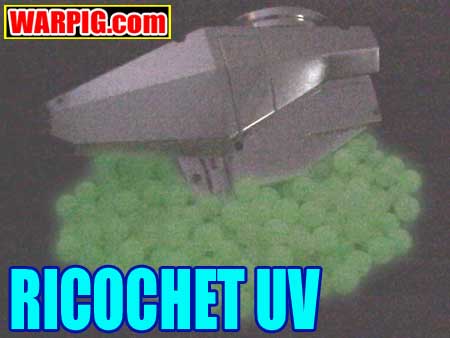
Ricochet UV
by Bill Mills
WARPIG.com readers got an exclusive
first look at the prototype of the Ricochet Loader in the summer of 2002.
During the fall of 2002, the Ricochet loader went from prototype to production
product. Here is a look at the final loader.
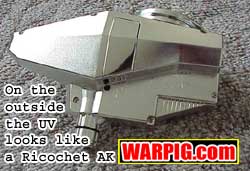 The
Ricochet UV is designed to work in conjunction with Crypt-O-Nite paintballs
from Wreched Seven. Crypt-O-Night paint glows in the dark.
Simply charging it with light and carrying it out to the paintball field,
however, one is faced with the serious limitation, that if not shot quickly,
the glow will run out. Charging with ultraviolet black lights is
the most efficient method for charging the paintballs, but even that yields
results that aren’t that impressive if the paint is shot very long after
it is charged. Since most night play happens during scenario games,
players are likely to be out on the field for an extended period of time. The
Ricochet UV is designed to work in conjunction with Crypt-O-Nite paintballs
from Wreched Seven. Crypt-O-Night paint glows in the dark.
Simply charging it with light and carrying it out to the paintball field,
however, one is faced with the serious limitation, that if not shot quickly,
the glow will run out. Charging with ultraviolet black lights is
the most efficient method for charging the paintballs, but even that yields
results that aren’t that impressive if the paint is shot very long after
it is charged. Since most night play happens during scenario games,
players are likely to be out on the field for an extended period of time.
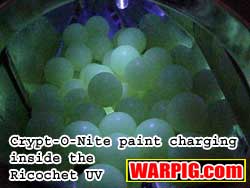 The
Ricochet UV, developed by Ricochet loader designer Ennis Rushton solves
the problem by charging the paintballs while they are in the hopper.
The Ricochet UV is built out of a mirrorized Ricochet AK loader body.
The UV circuit board is of the same design as the Ricochet AK board, but
labeled for the UV, and programmed with different software. Mounted
inside the Ricochet UV is a pair of additional circuit boards, each with
an array of Ultraviolet LEDs. These LEDs are the key, as the only
previous technology to produce a decent amount of ultraviolet light from
a compact battery power supply involved a high voltage drive circuit and
tube lamp fixture. In comparison to the LEDs, that old technology
was more complex, more expensive, and more fragile. The UV LEDs in
contrast, are sealed, waterproof solid-state semiconductor technology capable
of taking a lot of abuse, and needing relatively little power to operate. The
Ricochet UV, developed by Ricochet loader designer Ennis Rushton solves
the problem by charging the paintballs while they are in the hopper.
The Ricochet UV is built out of a mirrorized Ricochet AK loader body.
The UV circuit board is of the same design as the Ricochet AK board, but
labeled for the UV, and programmed with different software. Mounted
inside the Ricochet UV is a pair of additional circuit boards, each with
an array of Ultraviolet LEDs. These LEDs are the key, as the only
previous technology to produce a decent amount of ultraviolet light from
a compact battery power supply involved a high voltage drive circuit and
tube lamp fixture. In comparison to the LEDs, that old technology
was more complex, more expensive, and more fragile. The UV LEDs in
contrast, are sealed, waterproof solid-state semiconductor technology capable
of taking a lot of abuse, and needing relatively little power to operate.
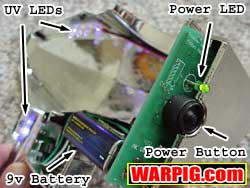 The
two LED arrays plug into the UV circuit board in the same plugs that an
AK board uses for its bend sensor, and agitating motor. With it’s
own unique software, the UV board simply provides power to these LEDs when
turned on, and not when it is off. A pushbutton on the rear of the
loader turns it on and off, and a small green LED lights when it is on.
Like the AK, the UV is powered by a single 9 volt battery. This is
much more convenient than the prototype model which required both the 9
volt, and a pair of AA batteries in a tray below it. The
two LED arrays plug into the UV circuit board in the same plugs that an
AK board uses for its bend sensor, and agitating motor. With it’s
own unique software, the UV board simply provides power to these LEDs when
turned on, and not when it is off. A pushbutton on the rear of the
loader turns it on and off, and a small green LED lights when it is on.
Like the AK, the UV is powered by a single 9 volt battery. This is
much more convenient than the prototype model which required both the 9
volt, and a pair of AA batteries in a tray below it.
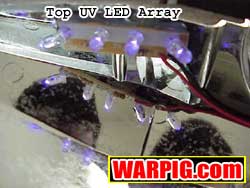 One
of the LED arrays is mounted in the top of the loader, aimed down at the
paintballs, while the other fits alongside the neck of the loader, giving
the paintballs a final strong charge on its way out of the loader.
According to Rushton, the choice of the mirrored finish is to make the
most of the UV light emitted from the LEDs. Light that doesn’t hit
a paintball bounces off the sides, back to the paint, rather than being
absorbed by the loader plastic. One
of the LED arrays is mounted in the top of the loader, aimed down at the
paintballs, while the other fits alongside the neck of the loader, giving
the paintballs a final strong charge on its way out of the loader.
According to Rushton, the choice of the mirrored finish is to make the
most of the UV light emitted from the LEDs. Light that doesn’t hit
a paintball bounces off the sides, back to the paint, rather than being
absorbed by the loader plastic.
Field testing the loader, it was found
to still be a good idea to charge up the paintballs with ultraviolet light
before heading out on the field. This, combined with the Ricochet
UV would maximize their brightness. At a minimum, it was helpful
to keep the Ricochet UV turned on between games, in the staging area, and
occasionally jostle it, to keep the paint stirred, so more paintballs were
directly exposed to the top LEDs.
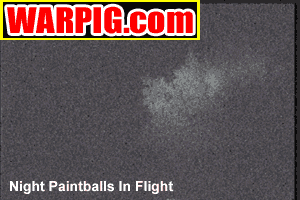 Under
the starlight of a clear sky, the paint was not brilliant, but definitely
bright enough to use as a tracer to walk a stream of paint onto a target.
On the receiving end, paint could be seen coming in, and splattering when
it hit surrounding trees and terrain, but it was difficult to use it to
pinpoint the exact position of the shooter. Oddly enough the paint
appeared to get brighter if the ball bounced off of something, or broke
open. This is because it would be slowed down by the impact, and
was then visible as more than just a streak through the air. Neither
the green LED on the back of the loader or the glowing paint inside were
visible enough to give away the shooter’s position. Under
the starlight of a clear sky, the paint was not brilliant, but definitely
bright enough to use as a tracer to walk a stream of paint onto a target.
On the receiving end, paint could be seen coming in, and splattering when
it hit surrounding trees and terrain, but it was difficult to use it to
pinpoint the exact position of the shooter. Oddly enough the paint
appeared to get brighter if the ball bounced off of something, or broke
open. This is because it would be slowed down by the impact, and
was then visible as more than just a streak through the air. Neither
the green LED on the back of the loader or the glowing paint inside were
visible enough to give away the shooter’s position.
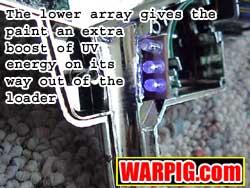 There
were two main downsides to the loader. First, the lower UV LED array
, meaning that the paint sitting in the breech of the paintgun, and the
feed neck did not get a fresh charge. The first few shots after a
period of waiting would not be nearly as bright as the following shots.
This is an area where pre-charging the paint before taking to the field
helped. The other drawback is that the Ricochet UV is not an agitating
loader, and is subject to jamming if it is used on a paintgun that does
not shake much during use. In testing on a Palmer’s Blazer, CCM J2
pump and Angel IR3, the pump was no problem, but with the semiautos, it
was necessary to shake the loader and paintgun after every burst of five
to six shots. Once this became a habit, it was not a problem.
Ricochet Development is considering the development of a future model which
will include both the Ricochet agitating system, and the ultraviolet LED
arrays. Keeping the loader about half full rather than completely
full helped significantly to reduce ball jam problems, as well as to allow
the paintballs to pick up more light from the top array. There
were two main downsides to the loader. First, the lower UV LED array
, meaning that the paint sitting in the breech of the paintgun, and the
feed neck did not get a fresh charge. The first few shots after a
period of waiting would not be nearly as bright as the following shots.
This is an area where pre-charging the paint before taking to the field
helped. The other drawback is that the Ricochet UV is not an agitating
loader, and is subject to jamming if it is used on a paintgun that does
not shake much during use. In testing on a Palmer’s Blazer, CCM J2
pump and Angel IR3, the pump was no problem, but with the semiautos, it
was necessary to shake the loader and paintgun after every burst of five
to six shots. Once this became a habit, it was not a problem.
Ricochet Development is considering the development of a future model which
will include both the Ricochet agitating system, and the ultraviolet LED
arrays. Keeping the loader about half full rather than completely
full helped significantly to reduce ball jam problems, as well as to allow
the paintballs to pick up more light from the top array.
Both the Ricochet UV and Crypt-O-Nite
paintballs are available from paintball dealers, and from assorted paintball
scenario game operators.
|





